(1)简单句、并列句及复合句
简单句,并列句,复合句
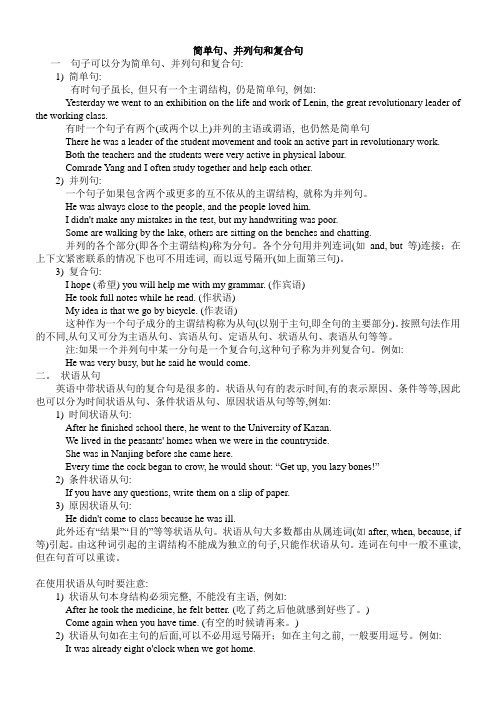
简单句、并列句和复合句一句子可以分为简单句、并列句和复合句:1) 简单句:有时句子虽长, 但只有一个主谓结构, 仍是简单句, 例如:Yesterday we went to an exhibition on the life and work of Lenin, the great revolutionary leader of the working class.有时一个句子有两个(或两个以上)并列的主语或谓语, 也仍然是简单句There he was a leader of the student movement and took an active part in revolutionary work.Both the teachers and the students were very active in physical labour.Comrade Yang and I often study together and help each other.2) 并列句:一个句子如果包含两个或更多的互不依从的主谓结构, 就称为并列句。
He was always close to the people, and the people loved him.I didn't make any mistakes in the test, but my handwriting was poor.Some are walking by the lake, others are sitting on the benches and chatting.并列的各个部分(即各个主谓结构)称为分句。
各个分句用并列连词(如and, but 等)连接;在上下文紧密联系的情况下也可不用连词, 而以逗号隔开(如上面第三句)。
3) 复合句:I hope (希望) you will help me with my grammar. (作宾语)He took full notes while he read. (作状语)My idea is that we go by bicycle. (作表语)这种作为一个句子成分的主谓结构称为从句(以别于主句,即全句的主要部分)。
英语句子分类之简单句,并列句和复合句
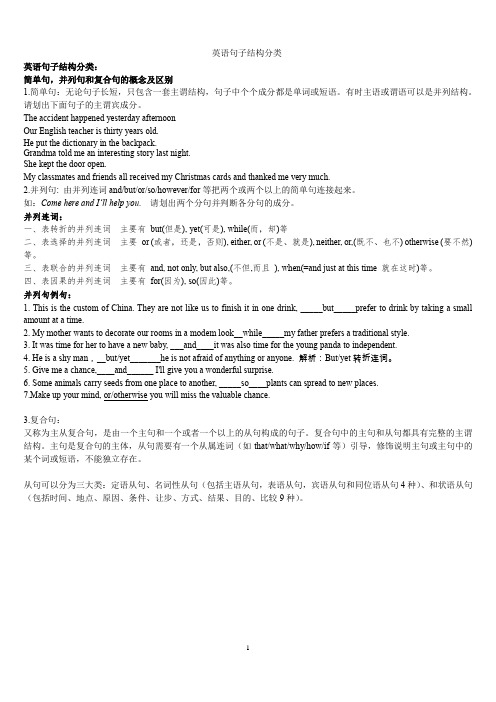
英语句子结构分类英语句子结构分类:简单句,并列句和复合句的概念及区别1.简单句:无论句子长短,只包含一套主谓结构,句子中个个成分都是单词或短语。
有时主语或谓语可以是并列结构。
请划出下面句子的主谓宾成分。
The accident happened yesterday afternoonOur English teacher is thirty years old.He put the dictionary in the backpack.Grandma told me an interesting story last night.She kept the door open.My classmates and friends all received my Christmas cards and thanked me very much.2.并列句: 由并列连词and/but/or/so/however/for等把两个或两个以上的简单句连接起来。
如:Come here and I’ll help you. 请划出两个分句并判断各分句的成分。
并列连词:一、表转折的并列连词主要有but(但是), yet(可是), while(而,却)等二、表选择的并列连词主要or (或者,还是,否则), either, or (不是、就是), neither, or,(既不、也不) otherwise (要不然)等。
三、表联合的并列连词主要有and, not only, but also,(不但,而且), when(=and just at this time 就在这时)等。
四、表因果的并列连词主要有for(因为), so(因此)等。
并列句例句:1. This is the custom of China. They are not like us to finish it in one drink, _____but_____prefer to drink by taking a small amount at a time.2. My mother wants to decorate our rooms in a modem look__while_____my father prefers a traditional style.3. It was time for her to have a new baby, ___and____it was also time for the young panda to independent.4. He is a shy man,__but/yet_______he is not afraid of anything or anyone. 解析:But/yet转折连词。
简单句 并列句 复合句
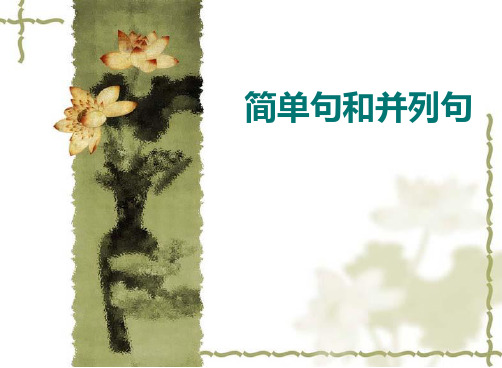
1. 陈述句(Declarative Sentences)
用来说明一个事实或陈述一种看法。例如: 1) Light travels faster than sound.
光比声传播速度快。(说明事实) 2) The film is rather boring.
这部电影很乏味。(说明看法)
要特别注意陈述句的否定结构
6. 状语 ( Adverbial )
常指修饰动词、形容词或副词的成分,修饰动词时 表示动作发生的时间、地点、目的或方式等;修饰 形容词或副词时表示它们的程度等。状语常由副词、 介词短语、动词不定式或分词短语等充当。 例如: 1. The miners work very hard. 2. She often helps Mike at school. 3. Hearing the news, he couldn’t help jumping.
3. 宾语 ( Object )
常指及物动词或介词后面使之意思完整的词或短语。 常由名词、代词、动词不定式或动名词短语等充当。 例如: 1. She has finished doing the experiment. 2. We like English and are good at it.
4. 表语 ( Predicative )
5)主 + 动 + 间宾 + 直宾 例如: My mother made me a new dress. 我母亲给我做了一件新衣裳。
IV. 并列句的常用连词
1. 我们常用并列连词and, not only…but also…等 连接联合并列句,用not only…but also… 时, 前面一句要用部分倒装 。例如: 1)Use your head, and you’ll find a way. 2)Not only does he want to come, but the students also need him.
复合从句

不可省略的连词:
介词后的连词不可省略 引导主语从句和同位语从句的连词不可省 略。 That she was chosen made us very happy. We heard the news that our team had won.
主语从句:作句子主语的从句叫主语从句
What he wants to tell us is not clear. 他要跟我们说什么,还不清楚。 Who will win the match is still unknown. 谁能赢得这场比赛还不得而知。 It is known to us how he became a writer. 我们都知道他是如何成为一名作家的。 Where the English evening will be held has not yet been announced. 英语晚会将在哪里举行,还没有宣布。
注意
当主语是reason时,表语从句要用that引导而不 是because。例如: The reason why he was late was that he missed the train by one minute this morning .
同位语从句:
同位语从句说明其前面的名词的具体内容。 同位语从句通常由that引导,that不可省略。 可用于同位语从句的名词有advice、demand、 doubt、fact、hope、idea、information、 message、news、order、problem、promise、 question、request、suggestion、truth、wish、 word等。 The news that we won the game is exciting. 我们赢得这场比赛的消息令人激动。 I have no idea when he will come back home. 我不知道他什么时候回来。
高考英语语法复习 ---简单句并列句复合句
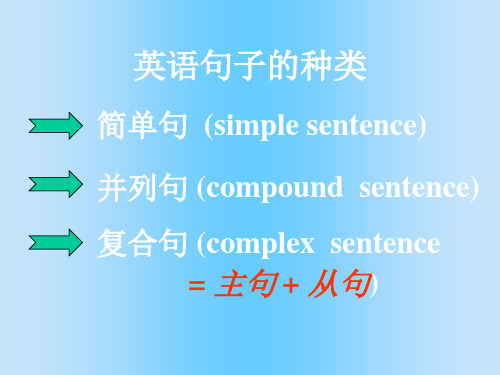
(武汉调研4月) Put yourself in situations where you will be forced to communicate in English, ___ you will see more progress over time. A. or B. so C. yet D. and (崇文4月) You must get up early in the morning, ___ we’ll have to leave without you A.and B. but C. or D. so
英语句子的种类
简单句 (simple sentence) 并列句 (compound sentence)
复合句 (complex sentence = 主句 + 从句)
简单句的五种基本句型
• 主语 + 不及物动词 ( S + Vi ) • 主语 + 及物动词 +宾语 ( S + Vt + O) • 主语 + 系动词 + 表 (S + LV + predicative) • 主语+双宾动词+间宾+直宾(S +Vt +O.indir+O. dir) • 主语 + 宾补动词 +宾语 +宾语补语 • (S + Vt. + O + O. compl) •There + be / stand/ lie / live...
其它平行结构:not…but…, either…or…, neither…nor, not only…but also…, would rather…than…(宁愿……不愿 ……), rather than(而不), as well as(既……也……)等。
简单句、并列句和复合句的区别

简单句、并列句和复合句的区别在英语中,句子根据句子结构可以分为:简单句、并列句和复合句。
你知道要怎么区别简单句、并列句和复合句吗?接下来,店铺跟你分享简单句、并列句和复合句的区别方法。
如何区分简单句、并列句和复合句简单句、并列句和复合句的区别一、简单句当一个句子只包含一个主谓结构时,我们称之为简单句。
The train(主语) has just touched down(谓语).在英语中,最基本的句型大体上有五种。
1. S+Vi:主语+不及物动词She sat down beside me.2. S+V+P:主语+系动词+表语Mother isn't in at the moment.3. S+Vt+O:主语+及物动词+宾语I hope to finish the work today.4. S+Vt+OI+OD:主语+及物动词+间接宾语+直接宾语My uncle gave me a camera.5. S+Vt+O+C:主语+及物动词+宾语+宾语补足语The news made us sad.备注:S:主语Vi:不及物动词Vt:及物动词O:宾语OD:直接宾语OI:间接宾语C:宾语补足语二、并列句两个或两个以上独立的主谓结构或简单句并列在一起,我们称之为并列句。
各个简单句间是平行并列的关系,而非从属关系。
并列句的各个分句间可用逗号、分号、起连接作用的副词或并列连接词来连接。
1. 能连接并列句的连词and(和,又),but(但是),for(因为),however(然而),or(或者),so(所以,因而),while(然而),yet(然而)2. 能连接并列句的复合连词or else(否则,要不然),either...or...(要么···,要么···;或者···,或者···),neither...nor...(既不···,也不···),not only...but also(不仅···,而且···)3. 能连接并列句的副词besides(而且,还有),hence(因此),otherwise(否则,要不然),then(然后,于是),therefore(因此,所以),thus(因而,从而) 根据并列分句之间的不同关系,并列句则可以分为以下四种。
语法一(简单句,并列句,定语从句)(
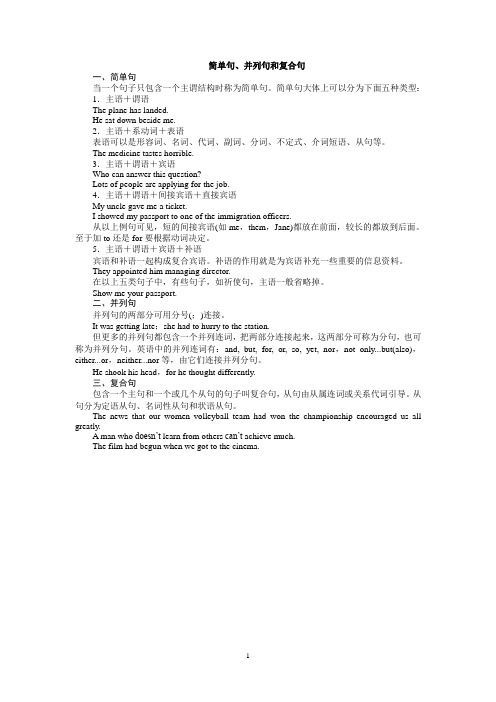
简单句、并列句和复合句一、简单句当一个句子只包含一个主谓结构时称为简单句。
简单句大体上可以分为下面五种类型:1.主语+谓语The plane has landed.He sat down beside me.2.主语+系动词+表语表语可以是形容词、名词、代词、副词、分词、不定式、介词短语、从句等。
The medicine tastes horrible.3.主语+谓语+宾语Who can answer this question?Lots of people are applying for the job.4.主语+谓语+间接宾语+直接宾语My uncle gave me a ticket.I showed my passport to one of the immigration officers.从以上例句可见,短的间接宾语(如me,them,Jane)都放在前面,较长的都放到后面。
至于加to还是for要根据动词决定。
5.主语+谓语+宾语+补语宾语和补语一起构成复合宾语。
补语的作用就是为宾语补充一些重要的信息资料。
They appointed him managing director.在以上五类句子中,有些句子,如祈使句,主语一般省略掉。
Show me your passport.二、并列句并列句的两部分可用分号(;)连接。
It was getting late;she had to hurry to the station.但更多的并列句都包含一个并列连词,把两部分连接起来,这两部分可称为分句,也可称为并列分句。
英语中的并列连词有:and, but, for, or, so, yet, nor,not only...but(also),either...or,neither...nor等,由它们连接并列分句。
He shook his head,for he thought differently.三、复合句包含一个主句和一个或几个从句的句子叫复合句,从句由从属连词或关系代词引导。
复合句,简单句,并列句 (1)

五种基本句型的推导: 五种基本句型的推导:
1 英语句子必须有谓语动词。 英语句子必须有谓语动词。 他像他爸爸。 他像他爸爸。 He is like his father. 这本书值得一读。 这本书值得一读。 The book is worth reading. 我反对你的意见。 我反对你的意见。 I’m against you. 2 一个句子内有且只有一个动词充当谓语(并列谓语除 一个句子内有且只有一个动词充当谓语( ),其余动词应为非谓语或从句的谓语 其余动词应为非谓语或从句的谓语。 外),其余动词应为非谓语或从句的谓语。 他给我一些水喝。 他给我一些水喝。 He gave me some water to drink.
(二)句子按其结构可以分为:简单句、并列句、复合句. 句子按其结构可以分为:简单句、并列句、复合句. 1)简单句:只含一个主谓结构. 简单句:只含一个主谓结构. 她喜欢集邮. 她喜欢集邮. She is fond of collecting stamps. 2)并列句:含两或两个以上主谓结构,句间由并列连词或分号 连接. 并列句:含两或两个以上主谓结构, 连接. 食物很精美,但他却没什么胃口. 食物很精美,但他却没什么胃口. The food was good, but he had little appetite. 3)复合句:含一个主句和一个或几个从句,从句由从属连词引导. 复合句:含一个主句和一个或几个从句,从句由从属连词引导. 我们到达电影院的时候,电影已经开演了. 我们到达电影院的时候,电影已经开演了. The film had begun when we got to the cinema.
复合句
d. Remember to write to your parents as soon as you get there.
简单句、并列句和复合句(包括五大句型)
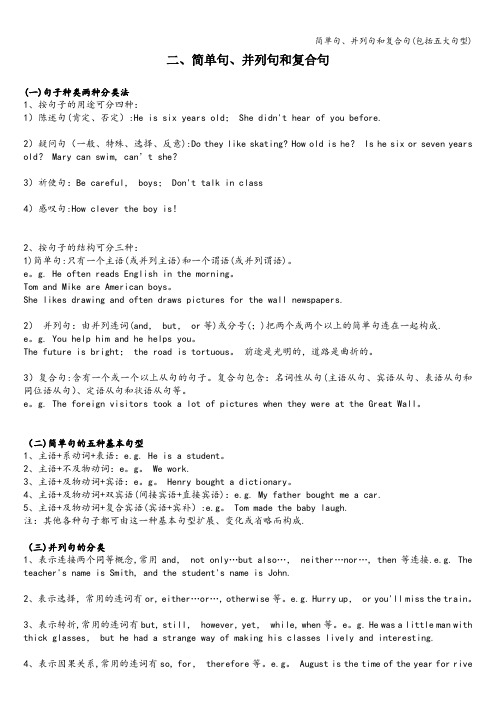
二、简单句、并列句和复合句(一)句子种类两种分类法1、按句子的用途可分四种:1)陈述句(肯定、否定):He is six years old; She didn't hear of you before.2)疑问句(一般、特殊、选择、反意):Do they like skating? How old is he? Is he six or seven years old? Mary can swim, can’t she?3)祈使句:Be careful, boys; Don't talk in class4)感叹句:How clever the boy is!2、按句子的结构可分三种:1)简单句:只有一个主语(或并列主语)和一个谓语(或并列谓语)。
e。
g. He often reads English in the morning。
Tom and Mike are American boys。
She likes drawing and often draws pictures for the wall newspapers.2)并列句:由并列连词(and, but, or等)或分号(;)把两个或两个以上的简单句连在一起构成.e。
g. You help him and he helps you。
The future is bright; the road is tortuous。
前途是光明的,道路是曲折的。
3)复合句:含有一个或一个以上从句的句子。
复合句包含:名词性从句(主语从句、宾语从句、表语从句和同位语从句)、定语从句和状语从句等。
e。
g. The foreign visitors took a lot of pictures when they were at the Great Wall。
(二)简单句的五种基本句型1、主语+系动词+表语:e.g. He is a student。
简单句,并列句和复合句
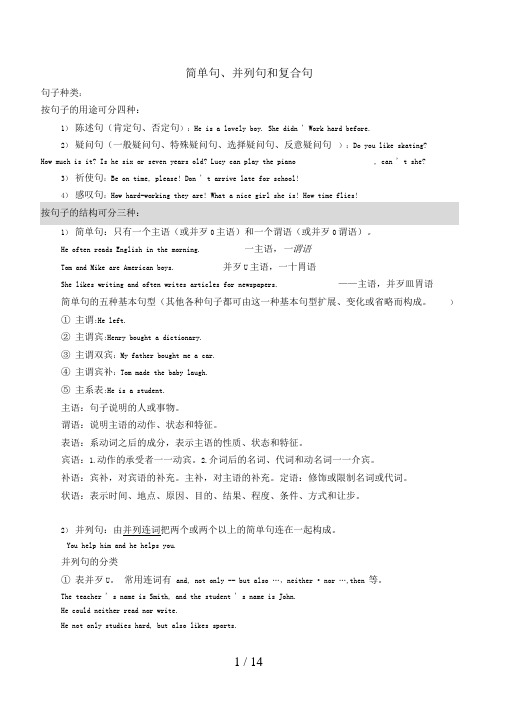
简单句、并列句和复合句句子种类:按句子的用途可分四种:1)陈述句(肯定句、否定句):He is a lovely boy. She didn ' Work hard before.2)疑问句(一般疑问句、特殊疑问句、选择疑问句、反意疑问句):Do you like skating?How much is it? Is he six or seven years old? Lucy can play the piano , can ' t she?3)祈使句:Be on time, please! Don ' t arrive late for school!4)感叹句:How hard-working they are! What a nice girl she is! How time flies!1)简单句:只有一个主语(或并歹0主语)和一个谓语(或并歹0谓语)。
He often reads English in the morning. 一主语,一谓语Tom and Mike are American boys. 并歹U主语,一十胃语She likes writing and often writes articles for newspapers. ——主语,并歹皿胃语简单句的五种基本句型(其他各种句子都可由这一种基本句型扩展、变化或省略而构成。
)①主谓:He left.②主谓宾:Henry bought a dictionary.③主谓双宾:My father bought me a car.④主谓宾补:Tom made the baby laugh.⑤主系表:He is a student.主语:句子说明的人或事物。
谓语:说明主语的动作、状态和特征。
表语:系动词之后的成分,表示主语的性质、状态和特征。
宾语:1.动作的承受者一一动宾。
2.介词后的名词、代词和动名词一一介宾。
简单句、并列句和复合句用法及历年高考题分析

简单句、并列句和复合句一。
考纲要求考试大纲要求考生能正确判断句子的类型、分析句子结构、结合语境和句意选择适当的连接词语、判断主语和从句的正确语序、恰当选择主句和从句谓语动词的时态。
二。
命题导向高考对简单句、并列句和复合句的考查主要包括:句子的结构、连词的选择、从句与主句的谓语动词的时态、主语和从句的语序、一些习惯用语和特殊的句式应用。
三。
复习要点1.简单句、并列句和复合句① 句子种类两种分类法按照句子的用途,英语的句子可分:陈述句(肯定、否定)、疑问句(一般、特殊、选择、反意)、祈使句、感叹句等四种。
按照句子的结构可分:简单句并列句和复合句三种。
简单句只有一个主语或并列主语和一个谓语或并列谓语。
并列句由并列连词and, but, or,so等)或分号(;)把两个或两个以上的简单句连在一起构成。
复合句:含有一个或一个以上从句的句子。
复合句包含:状语从句\名词性从句(主语从句、宾语从句、表语从句和同位语从句)和定语从句等三种。
② 并列句的分类并列句指把两个同等重要的句子连接在一起,句子之间常用and, not only…but also…, neither…nor…, then等并列连词连接。
表示选择关系常用的连词有:or, either…or…, otherwise等表示转折关系常用的连词有:but, still, however, yet, while, when等。
表示因果关系常用的连词有:so, for, therefore等。
2.状语从句:(1)状语从句的分类状语从句通常修饰主句的动词或整个句子,由从属连词引导,从属连词在从句中不充当句子成分。
根据状语从句所表达的不同意义和功能,可分为时间、地点、原因、条件、目的、结果、让步、比较、方式等状语从句。
(2)连接状语从句的词语时间状语从句:when, whenever每当……,after, before, as, as soon as, hardly/ scarcely...when..., no sooner...than.。
简单句、并列句和复合句

简单句、并列句和复合句句子按结构可分为简单句、并列句和复合句。
复合句中包含宾语从句、状语从句或定语从句等。
◆一简单句简单句就是只包含一个主谓结构的句子,其句式结构主要有五种:①主 + 谓。
He works in a big company. 他在一家大公司工作。
②主 + 系 + 表。
She is a kind girl. 她是一个善良的女孩。
③主 + 谓 + 宾。
Ann eats junk food twice a week .安一周吃两次垃圾食品。
④主 + 谓 + 间宾 + 直宾。
He gave me a pen .他给我一支钢笔。
⑤主 + 谓 + 宾 + 宾补。
He kept me waiting for two hours .他让我等了两小时。
◆二并列句并列句由两个或两个以上的简单句连接而成。
并列句中的各简单句同等重要,没有从属关系,是并列的关系,之间用并列连词连接。
1. 表示顺承的并列连词有and / not only …but (also)等。
如:She not only gaveus a lot of advice, butalso helped us to overcome difficulties .他不仅给了我们很多建议,而且还帮助我们克服困难。
2. 表示选择的并列连词有or,either …or …等。
如:Either you or Maria will haveto go .你或玛丽亚得去一趟。
3. 表示转折的并列连词有but,yet,however 等。
如:It is hot in summer here , butit’s not cold in winter .这里夏天热,但冬天不冷。
4. 表示因果关系的并列连词有so,如:He works hard , so he is one of the topstudents in our class .因为他学习努力,所以他是我们班最优秀的学生之一。
简单句,并列句,复合句
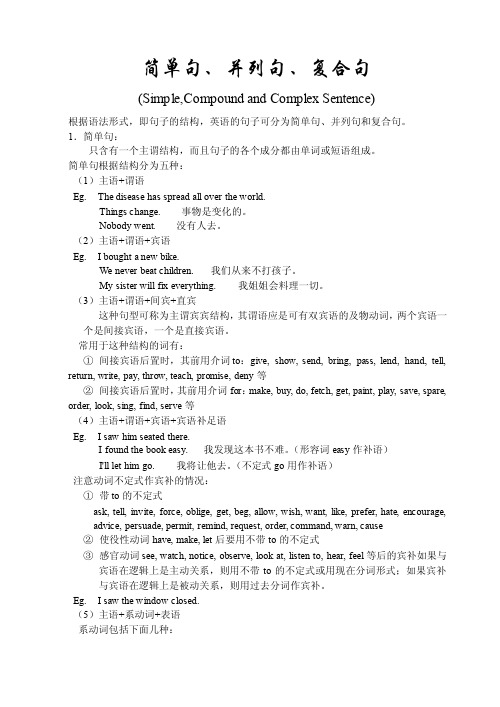
简单句、并列句、复合句(Simple,Compound and Complex Sentence)根据语法形式,即句子的结构,英语的句子可分为简单句、并列句和复合句。
1.简单句:只含有一个主谓结构,而且句子的各个成分都由单词或短语组成。
简单句根据结构分为五种:(1)主语+谓语Eg. The disease has spread all over the world.Things change. 事物是变化的。
Nobody went. 没有人去。
(2)主语+谓语+宾语Eg. I bought a new bike.We never beat children. 我们从来不打孩子。
My sister will fix everything. 我姐姐会料理一切。
(3)主语+谓语+间宾+直宾这种句型可称为主谓宾宾结构,其谓语应是可有双宾语的及物动词,两个宾语一个是间接宾语,一个是直接宾语。
常用于这种结构的词有:①间接宾语后置时,其前用介词to:give, show, send, bring, pass, lend, hand, tell, return, write, pay, throw, teach, promise, deny等②间接宾语后置时,其前用介词for:make, buy, do, fetch, get, paint, play, save, spare, order, look, sing, find, serve等(4)主语+谓语+宾语+宾语补足语Eg. I saw him seated there.I found the book easy. 我发现这本书不难。
(形容词easy作补语)I'll let him go. 我将让他去。
(不定式go用作补语)注意动词不定式作宾补的情况:①带to的不定式ask, tell, invite, force, oblige, get, beg, allow, wish, want, like, prefer, hate, encourage, advice, persuade, permit, remind, request, order, command, warn, cause②使役性动词have, make, let后要用不带to的不定式③感官动词see, watch, notice, observe, look at, listen to, hear, feel等后的宾补如果与宾语在逻辑上是主动关系,则用不带to的不定式或用现在分词形式;如果宾补与宾语在逻辑上是被动关系,则用过去分词作宾补。
简单句、并列句、复合句
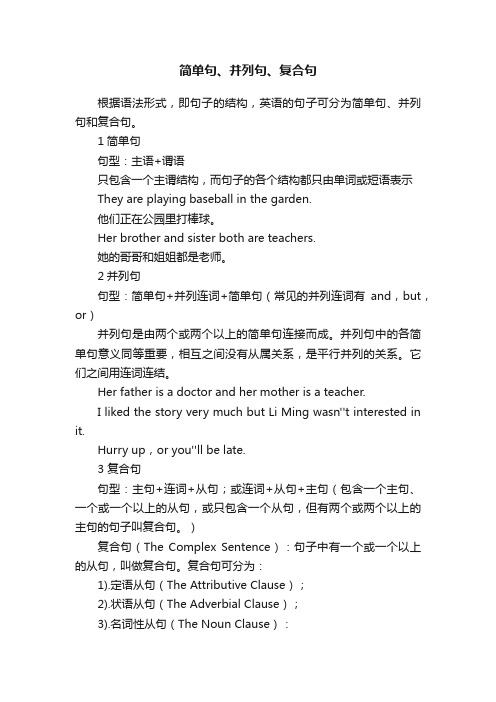
简单句、并列句、复合句根据语法形式,即句子的结构,英语的句子可分为简单句、并列句和复合句。
1简单句句型:主语+谓语只包含一个主谓结构,而句子的各个结构都只由单词或短语表示They are playing baseball in the garden.他们正在公园里打棒球。
Her brother and sister both are teachers.她的哥哥和姐姐都是老师。
2并列句句型:简单句+并列连词+简单句(常见的并列连词有and,but,or)并列句是由两个或两个以上的简单句连接而成。
并列句中的各简单句意义同等重要,相互之间没有从属关系,是平行并列的关系。
它们之间用连词连结。
Her father is a doctor and her mother is a teacher.I liked the story very much but Li Ming wasn''t interested in it.Hurry up,or you''ll be late.3 复合句句型:主句+连词+从句;或连词+从句+主句(包含一个主句、一个或一个以上的从句,或只包含一个从句,但有两个或两个以上的主句的句子叫复合句。
)复合句(The Complex Sentence):句子中有一个或一个以上的从句,叫做复合句。
复合句可分为:1).定语从句(The Attributive Clause);2).状语从句(The Adverbial Clause);3).名词性从句(The Noun Clause):一、定语从句定语从句的定义定语从句在句子中作定语,用来修饰一个名词、名词词组或者代词。
先行词和引导词被修饰的名词、名词词组或代词叫做先行词;在先行词和定语从句之间起连接作用的词叫做引导词。
引导词分为“关系代词”和“关系副词”。
关系代词和关系副词关系代词有:who, whom, whose, that, which, as。
高中英语语法大全知识点

高中英语语法大全知识点读书能获得知识;但更有用的知识对世界的认识却只能通过研究各种各样的人才能获得。
下面小编给大家分享一些高中英语语法大全知识,希望能够帮助大家,欢迎阅读!高中英语语法大全1简单句、并列句、复合句1. 简单句句型:主语+谓语只包含一个主谓结构,而句子的各个结构都只由单词或短语表示。
2. 并列句句型:简单句+并列连词(或连接副词)+简单句由两个或两个以上的简单句并列连接起来的句子叫并列句。
并列句中的各简单句意义同等重要,相互之间没有从属关系,是平行并列的关系。
它们之间用连词连结。
1、联合关系:常用的连词有and, not only…but(also), neither…nor等。
Eg. Tom doesn’t smoke, nor does his brother.2、转折关系常用的连词有but, yet, still, however, while(而,然而),when(那时,然后)等。
Eg. He got up very early, (and) yet he failed to catch the morning train.We played outside till sunset, when it began to rain.She is tired, (but) still she will make another test.yet 和still是连接副词,又叫半连接句。
however(然而,不过,但是)意义接近yet,可放在句首、句末或插入句子中间。
3、选择关系:常用的连词有or(或者,还是,否则),otherwise, or else,either…or等。
Eg. Hurry up, or we’ll be late for school.4、因果关系连词有:for, so, thus, therefore, and so 等。
Eg. He studied hard, thus he succeeded in passing the exam.The Frenchman coughed loudly, so he decided to go and get some medicine for it.for 表示附加或推断的理由、原因。
句子结构:简单句,并列句,复合句

He robbed me of a necklace.
The doctor cured her of cancer.
▲主语+谓语+宾语+补语
常见的宾语补足语有:形容词、副词、介词短语、名词、不定式、分词
eg. I made my sister angry. 主 谓 宾 补(形容词) They saw a puma running after them. 主 谓 宾 补(现在分词) I heard the window broken. 主 谓 宾 补(过去分词)
并列句 将几个简单句连接起来构成并列句,不存在单独的主句和从 句;各小句根据上下文的要求按逻辑次序排列,但各小句同 等重要并独立存在。
连接方式:
♥ 用分号,两个分句有逻辑关系
eg. We fished all day;we didn't catch a thing.
主
谓
状语
主
谓
Байду номын сангаас
宾
♥ 用连接副词,后常用逗号
分词
分词作状语时,一般在句子中作时间、原因、方式或伴随等状语。 分词作状语时,句子的主语就是该分词的逻辑主语。 现在分词: 1. 作后置定语,相当于定语从句 2.作伴随状语 (主语与主干的主语一致) 与主语为主动关系,所表示的动作一般与句中谓语动词所表示的动作同时发生 The manager acting for the company was in direct relation with the laborers. 后置定语 Playing basketball, Tom saw a stranger. 伴随状语 主句 Not having received a reply, he decided to write again. 原因状语 Crossing the road, I saw a girl crying. 时间状语 Being a child, he can’t enter into the interbar 原因状语
复合句

(2)关系副词引导的定语从句先行词是指时间、地点或理由的名词,引导词可用关系副词并在从句中作状语。
1)when, where, why 是关系副词,它们的含义相当于"介词+ which"结构,因此常常和"介词+ which"结构交替使用.Beijing is the place where (in which) I was born.北京是我的出生地。
2)怎样判断关系代词与关系副词方法一:用关系代词,还是关系副词完全取决于从句中的谓语动词。
及物动词后面跟宾语,就必须要求用关系代词;而不及物动词后不跟宾语,则要求用关系副词。
This is the mountain village where I stayed last year.I'll never forget the days when I worked together with you.习惯上总把表地点或时间的名词与关系副词where, when联系在一起。
方法二:准确判断先行词在定语从句中的成分(主、谓、宾、定、状),也能正确选择出关系代词/关系副词。
难点突破: 1. Is this museum ___ you visited a few days age?A. whereB. thatC. on whichD. the one2. Is this the museum ____ the exhibition was held?A. whereB. thatC. on whichD. the one例1变为肯定句:This museum is ___ you visited a few days ago.例2变为肯定句:This is the museum ___ the exhibition was held.在句1中,所缺部分为表语(也是先行词),而where, that, on which都不能起到先行词的作用,只有the one既做了主句的表语,又可做从句的宾语,而关系代词在宾语从句中作宾语,我们就可以省略关系代词,所以应选D。
(完整版)简单句、并列句、复合句、并列复合句
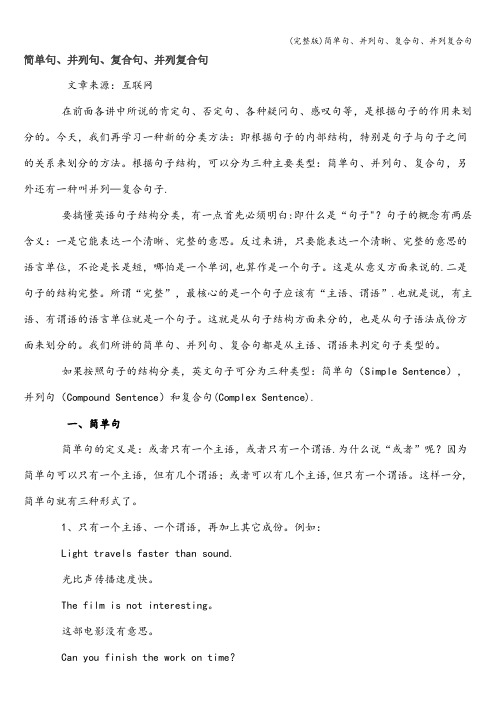
简单句、并列句、复合句、并列复合句文章来源:互联网在前面各讲中所说的肯定句、否定句、各种疑问句、感叹句等,是根据句子的作用来划分的。
今天,我们再学习一种新的分类方法:即根据句子的内部结构,特别是句子与句子之间的关系来划分的方法。
根据句子结构,可以分为三种主要类型:简单句、并列句、复合句,另外还有一种叫并列—复合句子.要搞懂英语句子结构分类,有一点首先必须明白:即什么是“句子"?句子的概念有两层含义:一是它能表达一个清晰、完整的意思。
反过来讲,只要能表达一个清晰、完整的意思的语言单位,不论是长是短,哪怕是一个单词,也算作是一个句子。
这是从意义方面来说的.二是句子的结构完整。
所谓“完整”,最核心的是一个句子应该有“主语、谓语”.也就是说,有主语、有谓语的语言单位就是一个句子。
这就是从句子结构方面来分的,也是从句子语法成份方面来划分的。
我们所讲的简单句、并列句、复合句都是从主语、谓语来判定句子类型的。
如果按照句子的结构分类,英文句子可分为三种类型:简单句(Simple Sentence),并列句(Compound Sentence)和复合句(Complex Sentence).一、简单句简单句的定义是:或者只有一个主语,或者只有一个谓语.为什么说“或者”呢?因为简单句可以只有一个主语,但有几个谓语;或者可以有几个主语,但只有一个谓语。
这样一分,简单句就有三种形式了。
1、只有一个主语、一个谓语,再加上其它成份。
例如:Light travels faster than sound.光比声传播速度快。
The film is not interesting。
这部电影没有意思。
Can you finish the work on time?你能按时完成工作吗?2、只有一个主语,但有几个谓语,再加上其它成份。
例如:The boy were running, shouting and laughing.男孩们一边跑,一边笑,一边喊叫着。
简单句并列句和复合句

• 注意:有些动词同时也是及物动词,可构成 SVO句式。
• He looked me up and down.他上下打量我。 He reached his hand to feel the elephant.
• 他伸出手来摸象。
• They are tasting the fish.他们在品尝鱼。 They grow rice in their hometown.
e.g. Henry bought a dictionary.
• 4、主语+及物动词+双宾语(间接宾语+直接宾 语):e.g. My father bought me a car.
• 5、主语+及物动词+复合宾语(宾语+宾补): e.g. Tom made the baby laugh.
• 注:其他各种句子都可由这一种基本句型扩展、 变化或省略而构成
含:名词性从句(主语从句、宾语从句、表语从句和同位 语从句)、定语从句和状语从句等。
• e.g. The foreign visitors took a lot of pictures when they were at the Great Wall
• 二、简单句 • 1、概述 • 只有一个主语和一个谓语动词的句子称为简
• 他挨冻受饿。
• China belongs to the third world country.
• 中国属于第三世界国家。
The gas has given out.煤气用完了。
• My ink has run out.我的钢笔水用完了。 Plants grow well all the year round.一年四季植物生 长良好。
单句。
- 1、下载文档前请自行甄别文档内容的完整性,平台不提供额外的编辑、内容补充、找答案等附加服务。
- 2、"仅部分预览"的文档,不可在线预览部分如存在完整性等问题,可反馈申请退款(可完整预览的文档不适用该条件!)。
- 3、如文档侵犯您的权益,请联系客服反馈,我们会尽快为您处理(人工客服工作时间:9:00-18:30)。
简单句、并列句及复合句1.[简单句] 当一个句子只包含一个主谓结构时称为简单句。
简单句大体可以分为下面五种类型:(1)主语+系动词+表语:(表语可以是形容词、名词、代词、副词、分词、介词短语、从句等)The flowers are sweet. 花很香(形容词)She is a clever girl. 她是一个聪明的女孩(名词)The handbag is mine. 手提包是我的(代词)Mother isn’t in at the moment. 妈妈此刻不在家(副词)The dish looks inviting. 这盘菜看起来很诱人(现在分词)She seemed well pleased. 她似乎很高兴(过去分词)Jane looks like her mother. 简的模样很像她妈(介词短语)That’s how I look at it. 这是我对它的看法(从句)(2)主语+动词(不及物动词)The bell rang. 门铃响了动词时态可以改,也可以有它的修饰语(状语)The bell is ringing loudly now. 门铃现在正大声地响着The bell has rang for 3 minutes. 门铃已经响了三分钟了(3)主语+动词+宾语(及物动词后直接加宾语,不及物动词需加适当的介词或副词)(A)I play football. 我踢足球。
(play 为及物动词)动词时态可以改,如:I was playing football at 10:00 yesterday. 我昨天十点时正在踢足球I have played football for 2 hours. 我已经踢了两个小时的足球了(B)She listens to music. (listen为不及物动词,后加介词to 再加宾语)We put the meeting off. (put 常与副词off连用,表推迟,宾语可居中) 以上宾语可由名词、代词、数词、不定式、动名词、从句等表示:They’re playing chess. 他们在下棋(名词)I have nothing to do today. 我今天没事干(代词)She wants two. 我要两个(数词)I hope to finish the work today. 我希望今天完成这项工作(不定式)I hate asking favors. 我不喜欢求人帮忙(动名词)You see what I mean. 你明白我的意思吗(从句)(4)主语+动词+间接宾语+直接宾语She gives me an apple. 她给我一个苹果一般间接宾语在前,直接宾语在后,也可把位置调换,但要加介词to 或forShe gives an apple to me. 她给我一个苹果She bought a skirt for her daughter. 她买了一件裙子给她女儿(5)主语+动词+宾语+补语(补语和宾语一起构成复合宾语,其作用是为宾语补充一些重要信息,补语可以是名词、形容词、不定式、现在分词或过去分词)They appointed him managing director. 他们任命他为总经理(名词)She painted the walls green. 她把墙漆成绿色(形容词)He told me to be more careful. 他让我仔细一点(不定式)I smelt something burning. 我闻到有东西烧焦味(现在分词)I have my hair washed. 我洗头了(过去分词)在以上五类句子中,有些句子,如祈使句,主语可省Show me your passport. 出示你的护照Paint the walls green. 把墙涂成绿色有些有并列成分,如两个主语、宾语、动词等:Tom and Jack are in the same class. 汤姆和杰克在同一个班He ordered a bee steak and a soup. 他叫了牛排和一份汤She came forward and shook hands with us. 她走上前和我们握手2. [并列句] 由两个或更多独立的主谓结构或简单句并列在一起的称为并列句。
这些独立句往往在意义上有所关联,否则会分成独立句子,不会连成并列句。
并列句的两部分可用分号连接。
英语中的并列连词有: and, but, for, or, so, yet, nor, not only…but (also), either…or, neither…norI like singing; she likes dancing. 我喜欢唱歌,而/但她喜欢跳舞I like singing, and/but she likes dancing.I’ ve got a cold, so I’ m going to bed. 我感冒了,因此我要去睡觉了The days were short, for it was now December. 白天很短,因为现在已经是十二月了You must hurry or you won’t make it for the train. 你得赶快,否则你会赶不上火车了还有一些副词也起连词作用,如:I think: therefore I am. 我思故我在3. [复合句] 一个句子如果有一个或多个成分由从句担任,它就是复合句。
它包括:(1) 名词性从句。
它在句中可担任主语、宾语、表语、介词宾语等That the match will be cancelled is now certain. 球赛将取消已经是肯定的了(主语)How it happened is a mystery to me. 这些是怎么发生的对我是一个谜(主语)I know (that) you’ll succeed. 我知道你们是会成功的(宾语)I wonder if you could stay for another day. 不知你可否再待一天(宾语)The question is whether they have signed a contract. 问题是他们签没签合同(表语)That’s why I object to the plan. 那就是我反对这个计划的原因(表语)It all depends on how we make the preparation. 这都取决于我们的准备工作做得怎样(介词宾语)I’m obliged to you for what you have done for us. 我很感激你对我们的帮助(介词短语)There is a rumour that he has married a widow. 有谣言说他和一个寡妇结了婚(同位语)The idea that money means everything is unsound. 金钱万能的思想是错误的(同位语)(2) 关系从句(定语从句),多由关系代词或关系副词引起A.由关系代词引起(that, who, whom, which, whose):This is the book which /that was on the table. 这就是桌上那本书(先行词指物,关系代词在从句中当主语,不可省)Jim introduced me to a girl who/that sat next to him. 吉姆把我介绍给坐他旁边的那女孩。
(先行词指人,关系化词在从句中当主语,不可省)This is the book (which/that)I borrowed yesterday. 这是我昨天借的书(关系代词在从句中当宾语,可省)She is the person (that/whom) I spoke to just now. 她就是刚才跟我说话的那个人(关系代词在从句中当宾语,可省)The girl whose book is here is away. 书在这里的那个女孩走了(先行词当定语)只用that, 不用which的有:1)You must do everything that I do. 你必须做我所做的每件事(先行词是all, little,much, few, nothing, everything 的,后用that)2)The only thing that we should do is to study. 我们唯一须做的事是学习。
(先行词前出现the only, the same, the last, the very 的用that)3)You can take away any book that is on the table. 你能拿走桌上的任何书(先行词被all, some, any, much, little, few 所修饰时,只用that)4)This is the best book that I have ever read. 这是我看过的最好的书。
(先行词前出再最高级及序数词,只用that)5)We talked about the things and persons that we are interested in. 我们谈论我们感兴趣的物和人(先行词既指人又指物时用that)只用which 不用that的情况有:1)This is the train by which we went to Guangzhou. 这是我们去广州所坐的火车(先行词后有介词,只用which)2)He said that which was not interesting. 他说那些不好玩的话(先行词是that 时,只用which,避免重复)3)At the station I bought some magazines that might help me pass the time on the trainand which I could pass on to the others when I finish them.在车站,我买了一些既可以帮我在为车上消磨时间,又可以在看完后给别人看的书(当句子有两个从句,前面用that 引导,后面要用which)4)My mother bought me a book, which I like very much. 我妈妈买了一本我很喜欢的书(在非限制性定语从句中,不能用that,只能用which)B.由关系副词引起(when, where, why)1)I will remember the day when I went to Beijing. 我会记得我去北京的那天(go为不及物,要加介词后才可用which,所以在此不可用which而用when,若要用which需加in, 即I will remember the day in which I went to Beijing.)对比:I will remember the day which I spent with you.(spend 是及物动词,可用which)2)This is the city where we lived before.(live为不及物,需用where,相当于in which)对比:This is the city which we visited before.(visit为及物动词,可用which)3)This is the reason why I came here. 这就是我来这里的原因。
